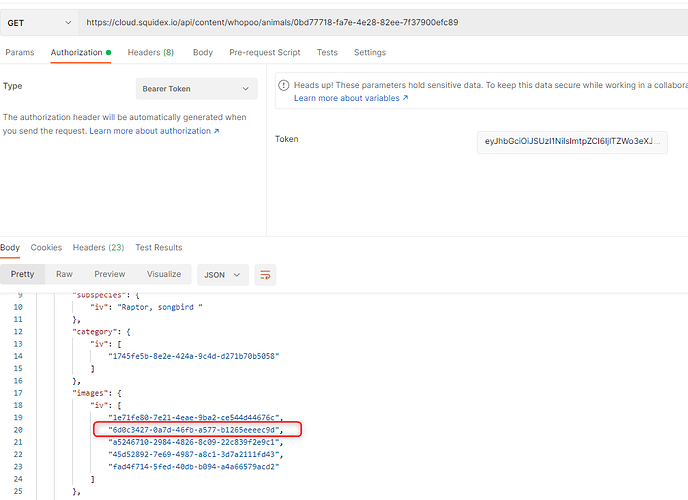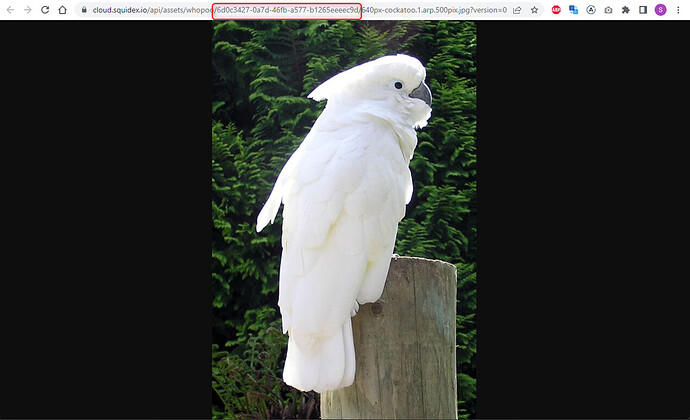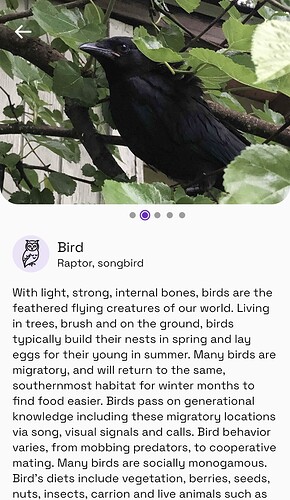"id": "0bd77718-fa7e-4e28-82ee-7f37900efc89",
"created": {
"value": "2021-04-21T20:17:40.000Z"
},
"createdBy": "client:whopoo:default",
"lastModified": {
"value": "2022-08-02T12:24:31.000Z"
},
"lastModifiedBy": "subject:600b1dba0b0f6802f930903d",
"version": {
"value": "16"
},
"status": "Published",
"statusColor": "#4bb958",
"scheduleJob": null,
"data": {
"species": {
"iv": "Bird"
},
"subspecies": {
"iv": "Raptor, songbird "
},
"category": {
"iv": [
"1745fe5b-8e2e-424a-9c4d-d271b70b5058"
]
},
"images": {
"iv": [
"1e71fe80-7e21-4eae-9ba2-ce544d44676c",
"6d0c3427-0a7d-46fb-a577-b1265eeeec9d",
"a5246710-2984-4826-8c09-22c839f2e9c1",
"45d52892-7e69-4987-a8c1-3d7a2111fd43",
"fad4f714-5fed-40db-b094-a4a66579acd2"
]
},
"description": {
"iv": "With light, strong, internal bones, birds are the feathered flying creatures of our world. Living in trees, brush and on the ground, birds typically build their nests in spring and lay eggs for their young in summer. Many birds are migratory, and will return to the same, southernmost habitat for winter months to find food easier. Birds pass on generational knowledge including these migratory locations via song, visual signals and calls. Bird behavior varies, from mobbing predators, to cooperative mating. Many birds are socially monogamous. Bird's diets include vegetation, berries, seeds, nuts, insects, carrion and live animals such as rodents, other birds, amphibians, reptiles and small mammals. Birds are characterized by feathered bodies, mostly toothless beaked jaws, flexible necks, the laying of hard-shelled, multi-colored eggs, a four chambered heart, being warm-blooded vertebrates and a high metabolic rate. The smallest bird is the less than three inches tall bee hummingbird, and the largest is the African ostrich over nine feet tall. Some birds, like penguins and ostriches, are flightless. However all birds have feathers, and have adapted to various climates to swim, jump, run and of course, fly. Birds are considered the only living dinosaurs. According to Leonardo Da Vinci's Codex on the Flight of Birds (written in 1506), currently held at the National Air and Space Smithsonian Museum: Those feathers that are farthest from the root can bend the most. Thus the tips of the feathers of birds will always be higher than the roots. So we can reasonably assume that the bones in the wings are lowered, and in raising these bones of the wings they will be higher than any other part of that wing. The heaviest part of the body of the bird guides its movement. Due to human destruction of nesting sites, poisoning, pollution, over-hunting, overconsumption, the exotic pet, feather and millinery trades, 120-130 bird species have gone extinct. Fun Fact: Emily Dickinson wrote \"I have a bird in spring / which for myself doth sing…\""
},
"scatDescription": {
"iv": "No odor, often white with black semi-solids or solids. The poo often is the consistency of toothpaste, neither too dry nor too wet. Can be used as fertilizer. Owl pellets often are hardened, dark packs containing bones and fur. "
},
"scatImages": {
"iv": [
"a4402d1c-1860-4f3e-ba4f-1aa1916105f7",
"018bebd1-583f-4a01-b9d8-943cd890cf1a",
"1ea655ce-403a-417c-8191-e16429a9ab88",
"c909b5a3-a270-47ea-a13e-982987d82a50",
"fc927fff-c372-470f-af11-9db1a2480c1d",
"1f200f89-960a-4515-9de3-f8b81f209b88",
"0e2bca71-a9c6-4a5a-bc3f-06084d36154b"
]
},
"scatLength": {
"iv": "<4"
},
"scatDiameter": {
"iv": "<1"
},
"trackDescription": {
"iv": "Three long, slender toes will often be visible"
},
"trackImages": {
"iv": [
"3917fa98-fad5-481b-b03b-1fcb63365537",
"e092b896-cfda-482b-acdf-034abd049a29"
]
},
"trackLength": {
"iv": "<3"
},
"trackWidth": {
"iv": "<3"
},
"habitats": {
"iv": "US"
}
},
"schemaName": "animals",
"schemaDisplayName": "animals",
"referenceFields": [
{
"fieldId": 1,
"name": "species",
"properties": {
"isRequired": false,
"isRequiredOnPublish": false,
"isHalfWidth": false,
"fieldType": "String",
"createEnum": false,
"editor": "Input",
"inlineEditable": false,
"isEmbeddable": false,
"isUnique": false,
"contentType": "Unspecified"
},
"isLocked": false,
"isHidden": false,
"isDisabled": false,
"_links": {},
"canAddField": false,
"canDelete": false,
"canDisable": false,
"canEnable": false,
"canOrderFields": false,
"canHide": false,
"canLock": false,
"canShow": false,
"canUpdate": false,
"partitioning": "invariant",
"nested": []
}
],
"_links": {
"self": {
"href": "/api/content/whopoo/animals/0bd77718-fa7e-4e28-82ee-7f37900efc89",
"method": "GET"
},
"previous": {
"href": "/api/content/whopoo/animals/0bd77718-fa7e-4e28-82ee-7f37900efc89/15",
"method": "GET"
},
"draft/create": {
"href": "/api/content/whopoo/animals/0bd77718-fa7e-4e28-82ee-7f37900efc89/draft",
"method": "POST"
},
"status/Archived": {
"href": "/api/content/whopoo/animals/0bd77718-fa7e-4e28-82ee-7f37900efc89/status",
"method": "PUT",
"metadata": "#eb3142"
},
"status/Draft": {
"href": "/api/content/whopoo/animals/0bd77718-fa7e-4e28-82ee-7f37900efc89/status",
"method": "PUT",
"metadata": "#8091a5"
},
"delete": {
"href": "/api/content/whopoo/animals/0bd77718-fa7e-4e28-82ee-7f37900efc89",
"method": "DELETE"
},
"patch": {
"href": "/api/content/whopoo/animals/0bd77718-fa7e-4e28-82ee-7f37900efc89",
"method": "PATCH"
},
"update": {
"href": "/api/content/whopoo/animals/0bd77718-fa7e-4e28-82ee-7f37900efc89",
"method": "PUT"
}
},
"canDelete": true,
"canDraftCreate": true,
"canDraftDelete": false,
"canCancelStatus": false,
"canUpdate": true,
"statusUpdates": [
{
"status": "Archived",
"color": "#eb3142"
},
{
"status": "Draft",
"color": "#8091a5"
}
]
}




